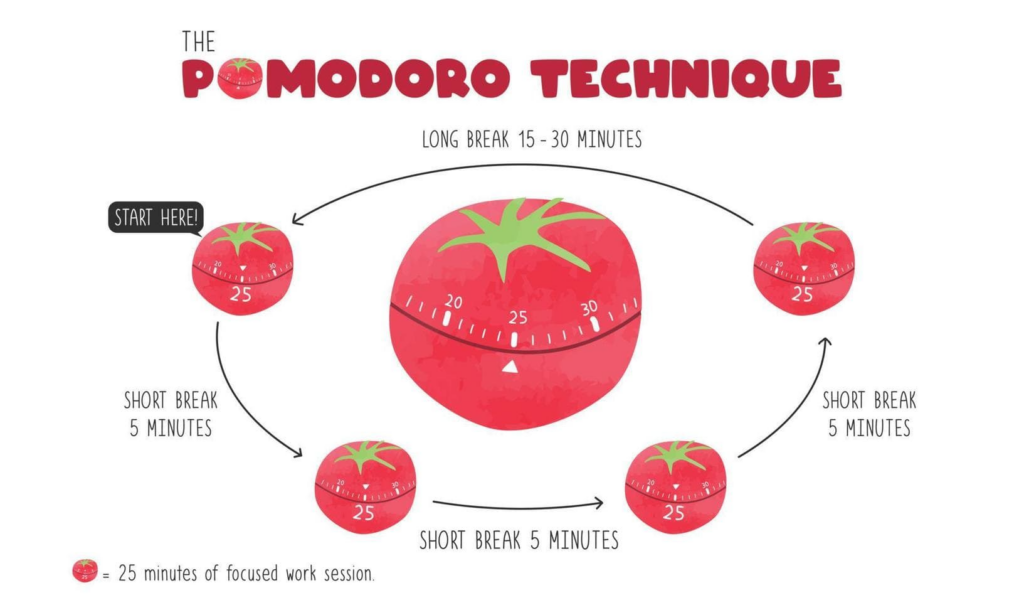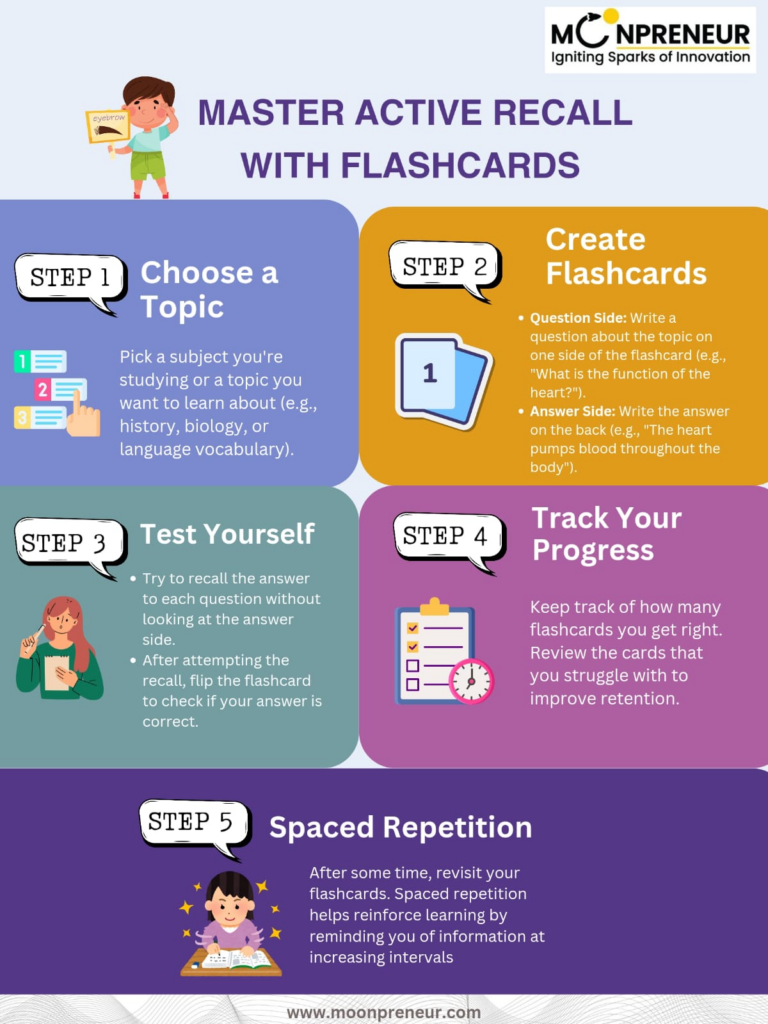Table of Contents
In today’s competitive world, studying efficiently is just as important as studying hard. With endless distractions and increasing academic demands, students and professionals need to maximize their learning potential without spending excessive hours buried in books that’s why we present you this Top 3 Smart Study Techniques to Learn Faster and Maximize Your Time.
While numerous strategies exist, three scientifically backed techniques stand out for their proven effectiveness in boosting memory retention, improving concentration, and enhancing overall learning efficiency:
- The Pomodoro Technique – A powerful time-management strategy that increases productivity and prevents burnout.
- Spaced Repetition – A scientifically validated method for reinforcing memory and retaining knowledge over time.
- Active Recall – A retrieval-based learning approach that significantly improves long-term understanding and recall.
Mastering these techniques can transform the way you learn, making study sessions more productive, effective, and enjoyable. However, many students struggle to implement these methods consistently on their own. This is where personalized tutoring services, like those offered by MST Tutoring, can make a significant difference. MST Tutoring provides expert guidance and customized study plans.
1. The Pomodoro Technique: Mastering Time Management for Efficient Learning

What is the Pomodoro Technique?
Developed by Francesco Cirillo in the 1980s, the Pomodoro Technique is a simple yet highly effective time-management strategy designed to optimize concentration and prevent mental fatigue. The method involves breaking work into focused study sessions (typically 25 minutes) called “Pomodoros,” followed by short breaks.
This structure aligns with the brain’s natural attention span, helping learners stay engaged, motivated, and productive throughout their study sessions.
The Science Behind the Pomodoro Technique
Research suggests that the human brain can maintain peak focus for about 20-30 minutes before attention starts to decline. A study conducted by the University of Illinois found that taking short breaks between work sessions significantly improves cognitive performance and reduces mental fatigue.
Moreover, studies in neuroscience show that our brain processes information more effectively when it works in cycles of intense focus followed by rest, making the Pomodoro Technique a scientifically validated approach to learning.
How to Implement the Pomodoro Technique
- Choose a Task – Select a study topic or assignment that requires deep focus.
- Set a Timer for 25 Minutes – Commit to uninterrupted studying during this time.
- Eliminate Distractions – Turn off notifications, close unnecessary tabs, and create a distraction-free environment.
- Work Intensely – Stay fully engaged with the task until the timer goes off.
- Take a 5-Minute Break – Stand up, stretch, or do a brief relaxation activity.
- Repeat the Cycle – After completing four Pomodoros (100 minutes of work), take a longer break (15-30 minutes) to refresh your mind.
Advanced Pomodoro Techniques for Even Better Results
- Customize Time Intervals – Some learners prefer 45-minute work sessions with 10-minute breaks instead of the traditional 25/5 model.
- Use the Two-Minute Rule – If a task takes less than two minutes to complete, do it immediately instead of adding it to your schedule.
- Track Your Pomodoros – Use apps like Forest, Pomodone, or Focus Booster to measure your productivity and track your Pomodoro sessions.
Real-World Applications of the Pomodoro Technique
- Medical Students: Use Pomodoro cycles to retain complex medical terms without burnout.
- Writers & Researchers: Maintain focus while writing long papers or conducting research.
- Software Developers: Break complex coding tasks into manageable chunks.
2. Spaced Repetition: Strengthening Memory for Long-Term Retention

What is Spaced Repetition?
Spaced Repetition is a highly effective memorization technique that involves reviewing information at increasing intervals to enhance long-term retention. Unlike cramming, which overloads the brain with too much information at once, Spaced Repetition strategically reinforces learning over time, making it easier to recall information when needed.
The Science Behind Spaced Repetition
The effectiveness of Spaced Repetition is backed by Hermann Ebbinghaus’ Forgetting Curve, which demonstrates how newly learned information is rapidly forgotten unless it is reviewed periodically.
A study published in Psychological Science found that students who reviewed material using Spaced Repetition techniques retained twice as much information as those who relied on last-minute cramming.
How to Implement Spaced Repetition
- Review New Information Within 24 Hours – Strengthen initial memory retention.
- Repeat the Review After 3 Days – Reinforce the material before forgetting sets in.
- Increase the Review Intervals – Review after 1 week, 2 weeks, 1 month, and so on.
- Use Flashcards and Apps – Leverage Anki, Quizlet, or SuperMemo, which use AI-driven algorithms to schedule reviews efficiently.
Advanced Strategies for Spaced Repetition
- The Leitner System – A flashcard-based method that prioritizes reviewing difficult concepts more frequently.
- Blurting Method – Write down everything you remember about a topic before checking notes to reinforce recall.
Real-World Applications of Spaced Repetition
- Language Learning: Review new vocabulary at increasing intervals for long-term fluency.
- Exam Preparation: Medical students use Spaced Repetition to memorize anatomy efficiently.
- Professional Training: Corporate employees retain training material better when spaced over weeks.
3. Active Recall: Boosting Learning Through Self-Testing

What is Active Recall?
Active Recall is one of the most powerful learning techniques, focusing on retrieving information from memory instead of passively reviewing notes or textbooks. By forcing the brain to recall facts actively, learners build stronger neural connections, making information easier to retrieve later.
The Science Behind Active Recall
A landmark study by Karpicke & Roediger (2008) showed that students using Active Recall techniques performed 50% better on exams compared to those using passive review.
Furthermore, MRI scans of individuals practicing Active Recall reveal higher engagement in the prefrontal cortex, the area responsible for memory consolidation.
How to Implement Active Recall
- Use Flashcards – Instead of reading notes, ask yourself questions and retrieve answers from memory.
- Self-Testing – Create practice quizzes and simulate exam conditions.
- Teach the Material – Explaining concepts aloud helps reinforce understanding.
- Summarize from Memory – Read a passage, then close the book and summarize key points without looking.
Advanced Techniques for Active Recall
- Cornell Note-Taking System – Write questions in the margin and answer them from memory.
- Brain Dumping – Write down everything you know about a topic without referring to notes.
Real-World Applications of Active Recall
- Medical Students: Recall medical diagnoses before checking textbooks.
- Law Students: Test knowledge of case law without relying on notes.
- Business Professionals: Prepare for presentations by practicing speeches from memory.
Mastering the Art of Efficient Learning
Mastering the art of efficient learning is not just about studying harder—it’s about studying smarter. With increasing academic and professional demands, maximizing learning efficiency has become a critical skill for students, professionals, and lifelong learners.
The Pomodoro Technique, Spaced Repetition, and Active Recall are three of the most effective study techniques, backed by scientific research and real-world applications. These methods enhance concentration, improve memory retention, and boost overall learning efficiency when used correctly.
Why These Techniques Work So Well
The reason why Pomodoro, Spaced Repetition, and Active Recall are so effective lies in how they interact with the brain’s cognitive functions and memory systems:
- The Pomodoro Technique helps manage cognitive load and prevents burnout by ensuring that the brain remains in an optimal state of focus. It takes advantage of the brain’s natural attention span and combats procrastination by creating a sense of urgency.
- Spaced Repetition reinforces learning by leveraging the spacing effect, which helps move information from short-term memory to long-term memory. This method ensures that learners don’t just memorize information temporarily, but actually retain it for future use.
- Active Recall strengthens neural pathways by forcing the brain to retrieve information, rather than passively reviewing it. This significantly enhances the ability to recall knowledge when it is needed most—such as during exams, presentations, or professional tasks.
These techniques work together seamlessly, complementing each other to maximize study efficiency. Pomodoro keeps you focused, Spaced Repetition ensures long-term retention, and Active Recall deepens understanding.
How to Make These Techniques a Habit
While these techniques are powerful, their effectiveness depends on consistent application. Here’s how to make them part of your daily study routine:
- Start Small – If you’ve never used these techniques before, begin by integrating one at a time. For example, start using the Pomodoro Technique for a week before incorporating Spaced Repetition and Active Recall.
- Use the Right Tools – Leverage technology to make these techniques easier to use. Apps like Anki, Quizlet, Forest, and Focus Booster can help automate and track your progress.
- Track Your Progress – Keeping a study journal or using productivity tracking apps can help you measure how well these techniques are working for you.
- Stay Flexible – Everyone learns differently, so adjust these techniques to fit your personal study habits. Some people may prefer longer Pomodoro sessions (45-minute focus, 10-minute breaks), while others may find shorter intervals (20-minute focus, 5-minute breaks) more effective.
- Combine with Other Learning Methods – While these techniques are highly effective, they work even better when combined with real-world application, discussions, and hands-on practice. For example, after using Active Recall to memorize a concept, try explaining it to someone else or applying it in a real-world scenario.
Long-Term Benefits of These Study Techniques
By incorporating Pomodoro, Spaced Repetition, and Active Recall into your study routine, you’re not just preparing for exams—you’re training your brain to learn more efficiently for life. These techniques offer several long-term benefits, including:
- Increased Productivity – By breaking study sessions into structured intervals, you complete tasks more efficiently and waste less time.
- Better Time Management – The Pomodoro Technique teaches you how to use your time wisely, making study sessions more effective.
- Improved Memory Retention – Spaced Repetition ensures that knowledge stays in your long-term memory, making it easier to recall even years later.
- Stronger Critical Thinking Skills – Active Recall forces you to engage deeply with the material, leading to better problem-solving abilities.
- Reduced Stress and Anxiety – By using these structured techniques, you can avoid last-minute cramming and burnout, leading to a more balanced and enjoyable learning experience.
Final Thoughts: Take Control of Your Learning
Education and knowledge acquisition are lifelong pursuits, and the way you study today will impact your success in the future. Whether you’re a student preparing for exams, a professional looking to enhance your skills, or simply someone who loves to learn, these techniques will empower you to study smarter, retain information longer, and maximize your potential.
By adopting Pomodoro for time management, Spaced Repetition for long-term retention, and Active Recall for deep learning, you can take control of your education and career. The key to success is not just the amount of time you spend studying but how effectively you use that time.
Start applying these techniques today, and you’ll not only become a faster, smarter learner, but you’ll also enjoy the process of learning more than ever before!
If you want to take your learning to the next level, consider working with experts who can guide you through the best strategies tailored to your needs. Visit MST Tutoring today and start studying smarter!
